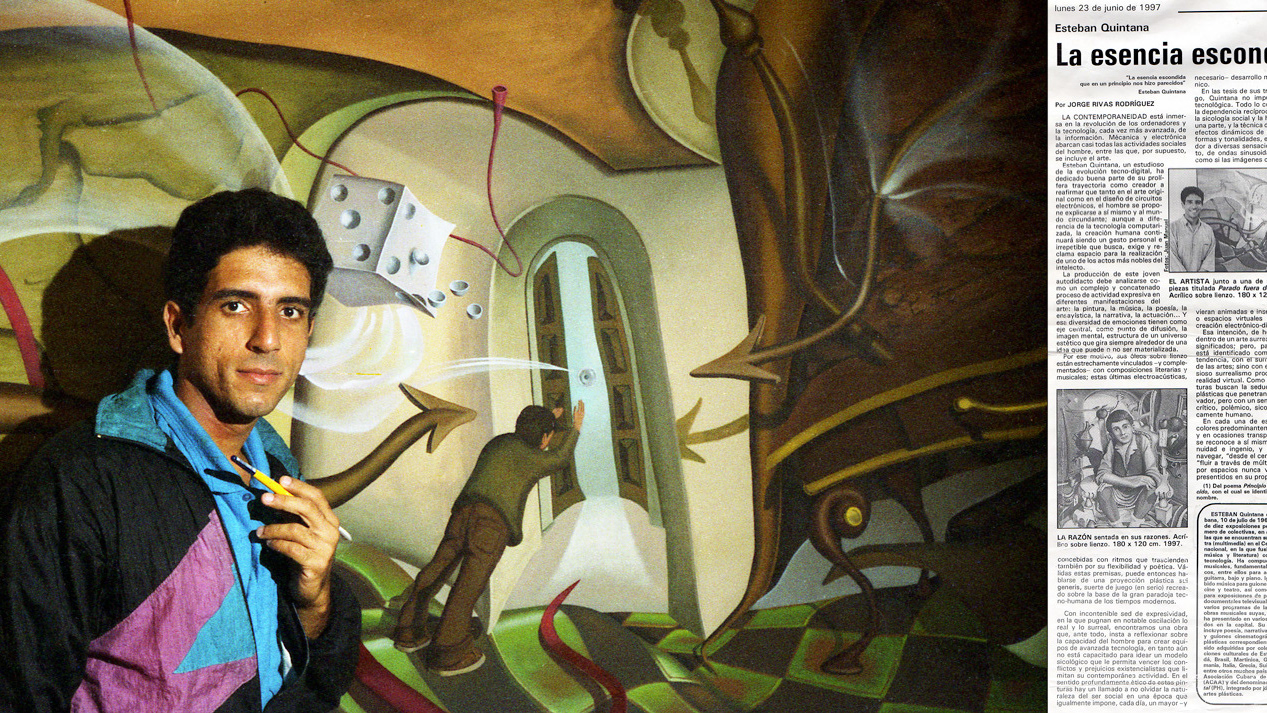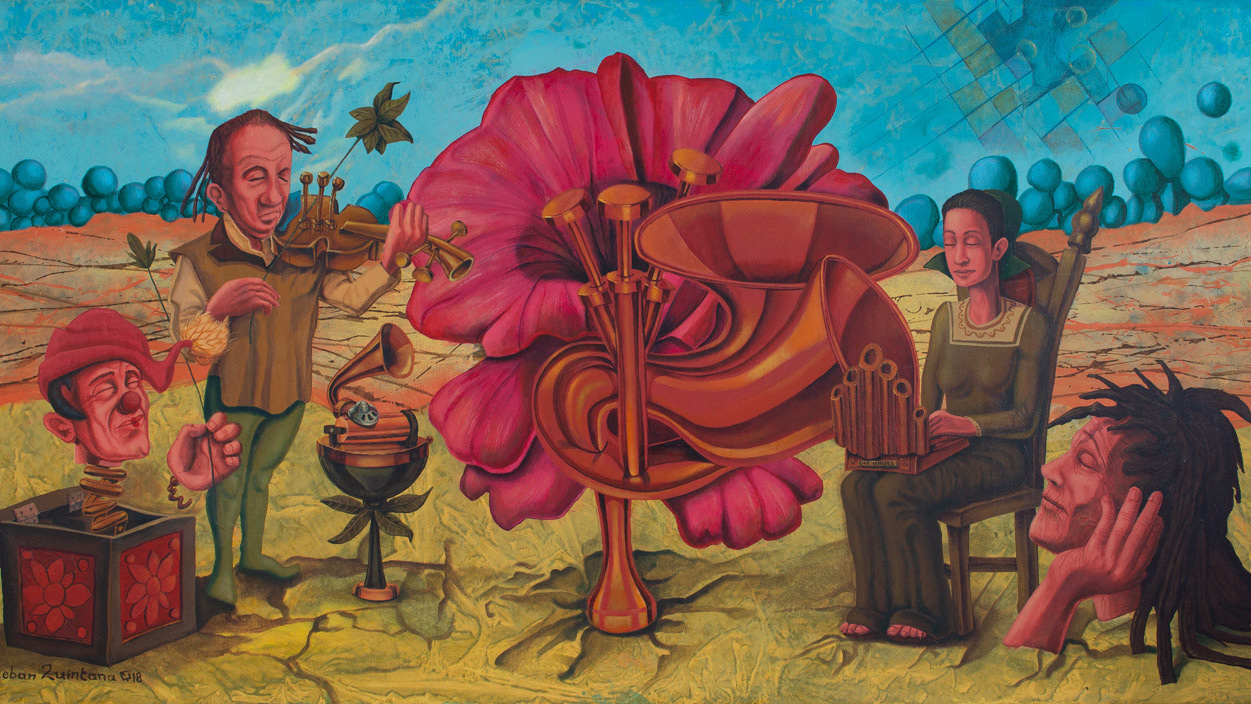Multimedia exhibition that recreates the ancient Egyptian Pharaonic civilization
Without a doubt, this was the most significant and unforgettable project of my life for many reasons. The most important, the unconditional support I received from friends, among them also artists, and from people who joined the idea with a great collaborative spirit, actively and selflessly getting involved to fulfill each of the stages that made this dream possible. For all these reasons, on August 1, 1990, El Hombre a Través del Tiempo ("Man Through Time") was presented at the Casa de los Árabes museum located at 16 Oficios St., between Obispo and Obrapía, Old Havana.
Unfortunately, there is a lot of material lost or in very bad condition. In addition, most of the pieces that participated in this exhibition no longer exist. Only the good memory of this project of all of us remains.
Notice: In case a participant of this exhibition has any photographic material, video, newspaper clipping or data not included in this site, that you consider useful to contribute to the memory of this event, please contact me. Thank you in advance.
The origin of the idea: why Pharaonic Egypt and why make a multimedia presentation?
The mystery of the pyramids, the belief in the world of Osiris or life after death, the hieroglyphic writing full of still indecipherable signs, their impressive artistic skill and knowledge for the construction of temples, for carving stones and working metal, with a unique and imposing aesthetic, the importance of their medicine, their social and universal values, among many other things, gave this subject enough importance to develop an artistic project based on the ancient Egyptian Pharaonic civilization, and also the beginning of a much broader idea entitled "Man Through Time".
Meanwhile, as I was carrying out my studies on this civilization, with the support of libraries such as the National Library of Havana, the Egyptian Embassy and friends, I progressively felt more and more impressed with everything I was receiving. For this reason, the idea of transmitting this experience to the public by way of immersion took shape, contemplating the presentation of this project as a multimedia.
The final result completely covered two floors of the Casa de los Árabes museum with sculptures made basically of paper pulp, papyrus reproductions, paintings, texts, music and dance.
The Making-of
Unfortunately, below I show the only photo I have of the making-of. It reflects the moment when one of the statues was basically molded with paper pulp, also using the traditional papier-mâché technique, as well as other elements such as plastics, wood, ropes and even iron supports to hold the weight.
The scene takes place in the courtyard of my house creating several of the pieces together with the artists Esteban and Alejandro-Alvarez Buylla, Eduardo Valladares, and myself (from the front sitting behind the statue). The photograph was taken by our friend Dr. Carlos A. Santamaría, who also made an impressive photo report on the day of the event.
As details in the scene, you can see in the left background, a part of the mask of Tutankhamun in the process of elaboration. In the background, the laundry room, the strainers and containers we used to turn newspapers into paper pulp. In the foreground, the flail (nekhakha) and crook (heka) of Pharaoh Tutankhamun made of wood, drying on the clothesline after being varnished.
Staff and flail: They were originally the attributes of the deity Osiris that became insignia of pharaonic authority. The shepherd's crook symbolized the status of king and the flail symbolized the fertility of the land.
Composition and recording of the ambient music
The idea was to combine the essence of Egyptian music with elements of contemporary music to produce an ambient sound, which complemented on the one hand, the character of the pieces exhibited, and on the other hand and in its final part, a celebratory atmosphere that was dedicated to the Feast of Opet, an Egyptian festival that celebrates the fertility provided by the waters of the Nile River when they flooded the land.
Before starting to compose, I carried out a research work where I was looking for sound and visual references of instruments of Egyptian music. I was fortunate to have at my disposal many references, thanks again to the National Library and the Egyptian Embassy in Cuba. So all that was left was to let inspiration flow and get down to work.
And once again, thanks to the support of good friends, I was able to start and successfully complete the process of composing and recording the ambient music. My friend and pianist Otto Caballero was at my disposal all the time, while on the other hand, he provided me with the synthesizer and sequencer with which I started the work. At the same time, I began to work on the final part of the celebration with another good friend, drummer and percussionist: Armando García, with whom I recorded the rhythmic part as a duo. The recording session took place in the studios of Radio Progreso, where I had the privilege of working with a sound legend like Ángel Larramendi and his team.
This was a very special day in which we completed another part of the project, a day that was joined by friends and collaborations, such as that of Eudualdo Antúnez of the band Monte de Espuma, who provided me with an additional synthesizer that came very well to the format of the recording session, or the photographer friend Angelito, who was in charge of immortalizing the moment.
Recording session in the studios of Radio Progreso with percussionist Armando García, Ángel Larramendi and his sound assistant. Year 1991. Photograph by: Angelito.
The Dance
Once the musical part was finished, it was time to meet the contemporary dancers of the Instituto Superior de Arte de la Habana (ISA). Their talent and ability made this part of the project to be understood and expressed in a brilliant way, something that was also felt by those attending the inauguration.
I would not want to fail to mention each of these dancers and their teacher, who with their effort and talent, turned the moment into a real Opet party. Unfortunately, their names are part of the missing information, so I would appreciate if someone can provide them to me.
Photograph by: Carlos A Santamaría.
Memories of the Exhibition
Here are the available images of that unforgettable event.
Reproduction of papyrus and writings. Photograph by: Carlos A Santamaría.
Scenes of the moment of the celebration, the Feast of Opet. Photograph by: Carlos A Santamaría.
Some of the exhibited pieces, basically made of paper pulp.
Newspaper clippings announcing the exhibition.




